World War II
The 106th Infantry Division's Headquarters and Headquarters Company was constituted in the Army of the United States on 5 May 1942, five months after the United States entered World War II. The division's numbering followed in sequence with the 105th Infantry Division, a planned African American infantry division that would be constituted on the Army's troop list, but never ended up being activated. The 106th Infantry Division was activated on 15 March 1943 at Fort Jackson, South Carolina, with a cadre from the 80th Infantry Division. Following basic and advanced infantry training, the Division moved on 28 March 1944 to Tennessee to participate in the Second Army No. 5 Maneuvers.
The 106th Infantry Division relieved the 2nd Infantry Division in the Schnee Eifel on 11 December 1944, with its 424th Infantry Regiment being sent to Winterspelt. Prior to the battle, according to the U.S. Army Service Manual, one division should be responsible for no more than 5 miles (8.0 km) of front. [1] On the eve of the battle, the 106th, along with the attached 14th Cavalry Group, was covering a front of at least 21 miles (34 km). [2]
In the Ardennes-Alsace Campaign, the Germans attacked the 106th on 16 December 1944. The division's 422nd and 423rd Infantry Regiments were encircled and cut off by a junction of enemy forces in the vicinity of Schönberg. They regrouped for a counterattack, but were blocked by the enemy. The two regiments surrendered on 19 December. The Germans gained 6,000 prisoners in one of the largest mass surrenders in American military history.
The remainder of the division that evaded the German pincer movement was reinforced by the 112th Infantry Regiment of the 28th Infantry Division and withdrew over the Our River and joined other units at Saint Vith. Along with the city of Bastogne to the south, St. Vith was a road and rail junction city considered vital to the German goal of breaking through Allied lines to split American and British forces and reach the Belgian port city of Antwerp. A scratch force of 106th Division personnel, in particular the division's 81st Engineer Combat Battalion, was organized and led by the 81st's 28-year-old commanding officer, Lt. Col. Thomas Riggs, in a five-day holding action (17–21 December) on a thin ridge line a mile outside St. Vith, against German forces vastly superior in numbers and armament (only a few hundred green Americans versus many thousands of veteran Germans). For this action, the 81st Engineer Combat Battalion was later awarded the Distinguished Unit Citation for gallantry. The defense of St. Vith by the 106th has been credited with ruining the German timetable for reaching Antwerp, hampering the Bulge offensive for the Germans. [3]
The 81st and other units, including the 168th Engineer Combat Battalion, pulled back from St. Vith on 21 December, under constant enemy fire, and withdrew over the Saint River at Vielsalm on 23 December. The following day, the 424th Regiment, attached to the 7th Armored Division, fought a delaying action at Manhay until ordered to an assembly area. From 25 December to 9 January 1945, the division received reinforcements and supplies at Anthisnes, Belgium, and returned to the struggle, securing objectives along the Ennal-Logbierme line on 15 January after heavy fighting. After being pinched out by advancing divisions, the 106th assembled at Stavelot on 18 January for rehabilitation and training. It moved to the vicinity of Hunningen on 7 February for defensive patrols and training.
In March, the 424th advanced along the high ground between Berk and the Simmer River and was relieved on 7 March. A period of training and security patrols along the Rhine River followed, until 15 March, when the division moved to St. Quentin [4] for rehabilitation and the reconstruction of lost units.
The division was reconstituted on 16 March when the 3rd Infantry Regiment (the Old Guard) and the 159th Infantry Regiment were attached to replace the two lost regiments. The division then moved back to Germany on 25 April, where, for the remainder of its stay in Europe, the 106th handled POW enclosures and engaged in occupational duties.
In the meantime, the 422nd Infantry Regiment and the 423rd Infantry Regiment were reconstituted from replacements in France on 15 April, were attached to the 66th Infantry Division in training status, and were still in this status when the Germans surrendered on 8 May 1945.
Casualties
- Total battle casualties: 8,627 [5]
- Killed in action: 417 [6]
- Wounded in action: 1,278 [7]
- Missing in action: 235 [8]
- Prisoner of war: 6,697 [9]
Notable members
Kurt Vonnegut served in this division and used his experiences during the Battle of the Bulge (and captivity as a prisoner of war) in his novel Slaughterhouse-Five. [22]
Master Sergeant Roddie Edmonds (died 1985), who was captured on 19 December 1944 as a member of the 422nd Infantry Regiment, was recognized in 2015 by Israel's Yad Vashem Holocaust memorial and museum as the first American serviceman from World War II to be honored with the title Righteous Among The Nations for risking his life to save Jewish-American POWs under his command from being taken from the POW camp in Germany to concentration camps, where they likely would have been murdered or worked to death. [23]
Donald Prell, futurologist and founder of Datamation, the first computer magazine, [24] served as the leader of the second anti-tank platoon in the 422nd Infantry Regiment, and several years following the war researched the biological basis of personality with the British psychologist Hans Eysenck. [25] Prell had been captured in the Battle of the Bulge, survived Allied aerial bombardment while locked in a boxcar with 59 other POWs, and then suffered freezing and starvation while in a German POW camp. [26]
Richard B. Parker, a Foreign Service Officer, served as the leader of the first platoon of the Anti-Tank Company of the 422nd Infantry Regiment and was captured and served as a POW. [27] Parker was an expert in Middle Eastern affairs and served as a U.S. Ambassador to Algeria, Lebanon and Morocco during the 1970s. [28]

The 7th Armored Division was an armored division of the United States Army that saw distinguished service on the Western Front, from August 1944 until May 1945, during World War II.
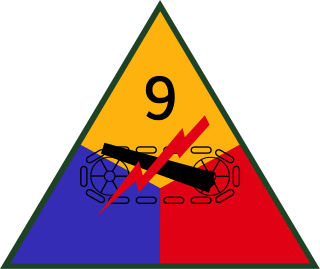
The 9th Armored Division was an armored division of the United States Army during World War II. In honor of their World War II service, the 9th was officially nicknamed the "Phantom Division."

The 11th Armored Division was a division of the United States Army in World War II. It was activated on 15 August 1942 at Camp Polk, Louisiana and moved on 24 June 1943 for the Louisiana Maneuvers. Transferred then to Camp Barkeley, Texas on 5 September 1943, the division participated, beginning 29 October 1943, in the California Maneuvers and arrived at Camp Cooke California on 11 February 1944. The division staged at Camp Kilmer, New Jersey from 16 to 29 September 1944 until departing New York Port of Embarkation on 29 September 1944, arriving in England on 11 October 1944.

The 87th Infantry Division was a unit of the United States Army in World War I and World War II.

The 80th Training Command is a formation of the United States Army Reserve.

The 103rd Infantry Division was a unit of the United States Army that served in the U.S. Seventh Army of the 6th Army Group during World War II.
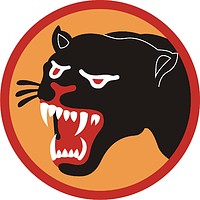
The 66th Infantry Division was a unit of the United States Army during World War II. Activated 15 April 1943, the division trained at Camp Blanding, Florida, and was later transferred to Camp Robinson, Arkansas and then later to Camp Rucker, Alabama before being shipped overseas to England on 26 November 1944. Commanded by Maj. Gen. Herman F. Kramer, the 66th Infantry Division's main role in World War II was containing and eliminating the remaining pockets of German soldiers in Northern France.

The 90th Infantry Division was a unit of the United States Army that served in World War I and World War II. Its lineage is carried on by the 90th Sustainment Brigade.

The 99th Infantry Division briefly existed, but never deployed, in the closing days of World War I, was reconstituted as a reserve unit in 1921, was ordered into active military service in 1942, and deployed overseas in 1944. The 99th landed at the French port of Le Havre and proceeded northeast to Belgium. During the heavy fighting in the Battle of the Bulge, the unit suffered many casualties, yet tenaciously held its defensive position. In March 1945, the 99th advanced into the Rhineland, crossing the Rhine River at Remagen on March 11. After fighting in the Ruhr area, the unit moved southward into Bavaria, where it was located at the end of the war.

The 71st Infantry Division was a unit of the United States Army in World War II.

The 31st Infantry Division ("Dixie") was an infantry division of the United States Army National Guard, active almost continuously from 1917 to 1968. Composed of men from Alabama, Florida, Georgia, Louisiana, Michigan, Illinois, and Mississippi at various points in its existence, the division saw service in both World War I and World War II, and was mobilized during the Korean War, although it was not sent overseas in the latter.

The 27th Infantry Division was a unit of the Army National Guard in World War I and World War II. The division traces its history from the New York Division, formed originally in 1908. The 6th Division designation was changed to the 27th Division in July 1917.

The 26th Infantry Division was an infantry division of the United States Army. A major formation of the Massachusetts Army National Guard, it was based in Boston, Massachusetts for most of its history. Today, the division's heritage is carried on by the 26th Maneuver Enhancement Brigade.
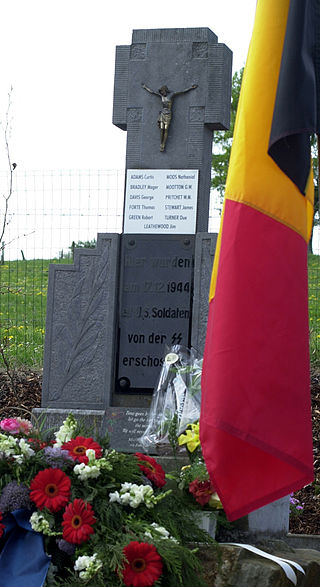
The 333rd Field Artillery Battalion was a racially segregated United States Army unit of African-American troops during World War II.

The 106th Cavalry Regiment was a mechanized cavalry unit of the United States Army in World War II recognized for its outstanding action. The group was organized in 1921 as part of the Illinois National Guard and during the Spanish–American War and World War I was known as the 1st Regiment Illinois Volunteer Cavalry. It underwent a number of reorganizations before World War II. Like other Guard units during the inter-war years, the 106th held weekly or monthly drills and yearly training. Readiness for war in 1940 led to the mechanization of the unit and induction into federal service at Camp Livingston, Louisiana on 25 November 1940.

The 395th Infantry Regiment was an infantry regiment of the United States Army, part of the 99th Infantry Division during World War II. It was organized with the rest of the 99th on 16 November 1942 at Camp Van Dorn, Mississippi. During the Battle of the Bulge, the regiment—at times virtually surrounded by Germans—was one of the few units that did not yield ground to the attacking Germans. On at least six occasions they called in artillery strikes on or directly in front of their own positions. Their success in defending Höfen resulted in the 395th Infantry being repeatedly assigned to other divisions for difficult assignments during the remainder of the war, earning them the sobriquet, Butler's Blue Battlin' Bastards. The unit was inactivated after World War II, then became a reserve unit, and was redesignated as the 395th Regiment in 1999.
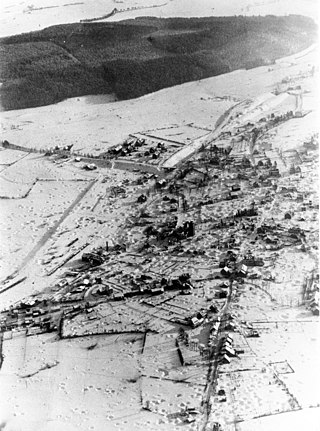
The Battle of St. Vith was an engagement in Belgium fought during the Allied advance from Paris to the Rhine in World War II. It was one of several battles on December 16, 1944 constituting the opening of Germany's Ardennes counteroffensive.
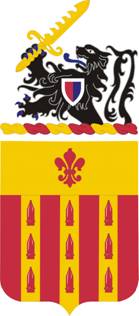
The 333rd Field Artillery Regiment is a regiment of the Field Artillery Branch of the United States Army.

The Battle of Clervaux or the Battle for Clervaux was an opening engagement of the Battle of the Bulge that took place in the town of Clervaux in northern Luxembourg. It lasted from December 16 to 18, 1944. German forces encircled numerically inferior American forces, primarily from the 28th Infantry Division's 110th Infantry Regiment and the 109th Field Artillery Battalion, and quickly forced them to surrender. The battle has been referred to as the Luxembourg "Alamo".

Major General Alan Walter Jones was a career officer in the United States Army. He is best known for his command of the 106th Infantry Division during World War II.





















